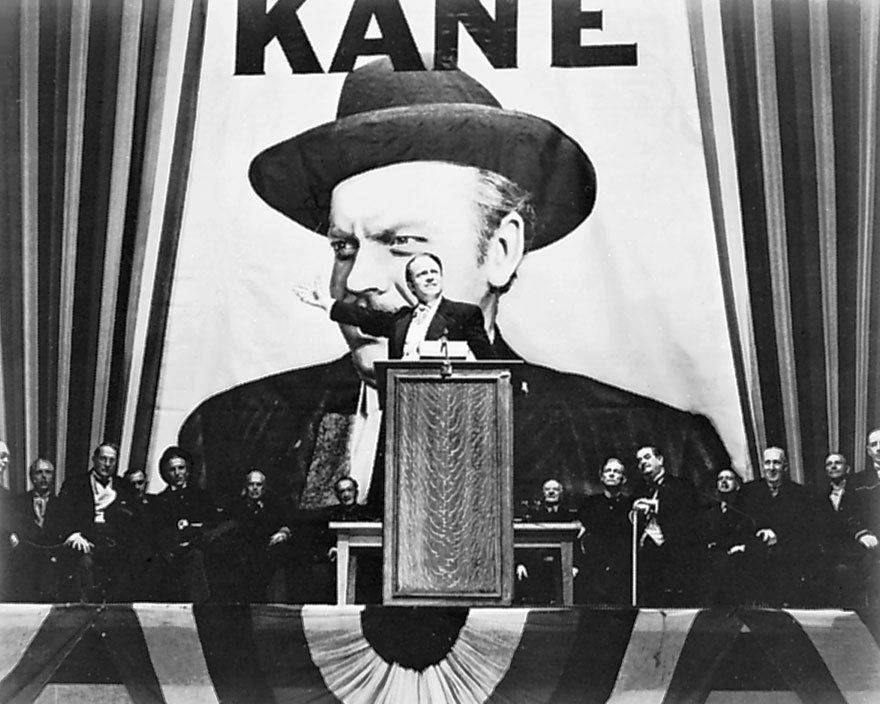What purpose drives one when one’s first creation is hailed among the greatest? Perhaps this was the thought that crossed the mind of Orson Welles after he brought Citizen Kane into existence. His utter brilliance in the fields of acting, directing and writing movies has cemented his place in the top most ranks of Hollywood. After his acclaimed legendary work, he had struggled to live up to the fame that he had achieved. Yet, the movies that followed were neither sub-par nor average. One could say that his tenacity, dedication to his craft and his innate talent for cinema has paid off. His later movies are now seen as masterpieces. His legacy lies not in a single hit but in the collection of films that he made over time.
Let us go back in time and remember the timeless classics that Orson Welles created in the world of cinema.
9. The Stranger (1946)
The Stranger was made almost as a bet against Hollywood. The movie was to be proof of the fact that Orson Welles was not limited to his canon genre only. He could spread his wings and deliver what was essentially a formula Hollywood movie. Perhaps that is the reason as to why many critics have called it generic or a run-of-the-mill kind of production. In the film, we see Welles trying to blend in. Most of the stand-out features of his cinematography are absent. He has given his blandest interpretation of what passed as Hollywood thrillers in the ’40s.
But since this is Welles we are talking about, the end product was actually pretty good. It did lack the complex narratives and stylized visuals. But the movie held its own as one of the best thrillers of its time. The movie did earn Welles an Oscar nomination for its screenplay. Essentially, it reset his waning career. Many have said that it is a rehash of a Hitchcock movie since their plots are somewhat similar. But even in this generic work for work’s sake movie, Welles has added some of his own subtle characteristics.
8. Othello (1951), Macbeth (1948)
There surely exists an intimate artistic relationship between Orson Welles and William Shakespeare. For without it, such visual and narrative masterpieces would never have been possible. Welles’ Othello and Macbeth are direct retellings of the marvelous plays by Shakespeare, of the same names. The director has outdone himself with cinematography and location selection. Morocco, Venice, Tuscany, and Rome afford an authentic character to the movies. Add to that some period-accurate environment and wardrobe, and what you get is some of the most faithful recreations of the most iconic plays in the history of English literature.
Despite the authenticity, the films scream Welles. They are a roaring reflection of his filmography. The meticulous editing with an added tinge of madness and malice provide us with works of art that transcends the boundaries of theater and cinema.
7. F for Fake (1973)
F for Fake is kind of a wickedly fun documentary movie that mainly focuses on fakers. These fakers or forgers are people who copy the masters and their artforms to such a perfect degree that their work becomes comparable to theirs. The movie explores the world of fraud and forgery through the eyes of Elmyr de Hory, a brilliant art forger, and his forger biographer Clifford Irving.
The film intelligently uses symbols and humor. It engages the audiences with a premise that is quite interesting and keeps them entertained with a deep discussion on the philosophical aspects of art, mastery, and fraud. All in all, it is a wonderfully crafted masterpiece whose inner workings are so subtle and nuanced words fall short in explaining them.
6. The Lady From Shanghai (1947)
A noir film from Orson Welles is always a treat. And The Lady From Shanghai rests on the peak of this genre. It is a stylistic masterpiece that delves into deception and the creation of a self-image. It follows an investigation of a faked death. It’s a typical noir film that zeroes in on the falsehoods of society. It is actually an elaborate set up in which a man gets caught up completely. He is unable to escape and the court proceedings that go into his defense are almost electric.
The film is a dynamic work of editing and artistry that aptly depicts the disturbed mentality of the protagonist. It also showcases some interesting use of symbols. These visual hints allow the audiences to decipher the thoughts within the minds of the characters. It gives the world a more dreamlike feel and makes the frantic confusion a bit more comprehensible.
5. The Trial (1962)
Orson Welles claims that his greatest work was not Citizen Kane. It was actually The Trial. This movie is based on Franz Kafka’s book of the same name. And truth be told, this union is amazing as we see much of Kafka’s labyrinth-like narrative style in the filmmaking of Orson Welles. The film shines and lives a life of its own. It has so much character that it has the potential to suffocate the viewers with its idea of a totalitarian regime. Welles has depicted this unpenetrable vision of a bureaucratic prison from which escape is impossible.
The protagonist played by Anthony Perkins is a brilliant character. He embeds his fear and uneasiness within us. We too feel that escape from the clutches of the ‘law’ is impossible. The movie manages to draw this immense tension that gives us no respite. The atmosphere itself is adamant to make us surrender to a sort of claustrophobic anxiety that eats us from within. The feeling of not knowing what crime one has committed and being prosecuted for it is a sentiment that can instill true dread into anyone’s mind. The film clutches you by the nape and gives not a single moment of peace. The extreme tension that is built in it speaks volumes about Orson Welles’ directional capabilities.
4. The Magnificent Ambersons (1943)
The second film of Orson Welles, The Magnificent Ambersons tried to be something that had tried its best not to become another Citizen Kane. But the driving character of the film resembled Kane in a lot of ways. His wealth, rotten demeanor, etc. all were akin to Kane’s. But Welles was able to paint a different picture through his second outing. The Magnificent Ambersons is a story about a changing America and the plight of those whose lives were being changed simultaneously.
The movie takes us through a time in which social standings are very volatile and subject to rapid change. We witness the reactionary thoughts of those who are stuck in between. The views of the people who are being brought down from a higher social standing as the industrial revolution booms with the aid of the automobile industry are interesting, to say the least. Their anxieties and the way they melancholically reminisce about an era that has perhaps already passed truly touches upon the socio-economic mobility dynamic of the nation.
And within this social documentary, Orson Welles integrates what is perhaps one of the most riveting tales of love battling with selfishness. We witness the rotten son stand in between the love affair of his mother and the man she loves. The ambiguity of morality and the final acceptance of fault act as one of the best cathartic elements in the film.
3. Chimes at Midnight (1965)
Sir John Falstaff – the preferred fool of many a Shakespearean play, finally gets his chance to shine in Orson Welles’ Chimes of Midnight. Several critics consider it the best Shakespearean adaptation. Orson Welles has made Falstaff a heroic, comedic and tragic character all blended into one. This transformation is phenomenal. We see through the perspective of the lazy, fun-loving and fat knight (who really resembles Seigmeyer of Catarina from Dark Souls). It is almost as if we are taking a look at the medieval times through the eyes of someone with whom we can actually relate.
Welles stays true to the source material. He completely justifies the portrayal of Falstaff. But along with the authentic reimagining, he also puts in an additional visual and narrative flair. The hilarious and very likable companion of Prince Hal puts himself in situations that are larger than him. Yet he navigates through these unbelievable events with ease and comic charm. What is special about the film is the way in which the character carries himself through the world, oblivious to its dangers and responsibilities; reveling in the mad joy of life.
2. Touch of Evil (1958)
Touch of Evil was a noir thriller that was Welles’ last movie with a big Hollywood studio. And it was a true cinematic masterpiece. The realism portrayed in it was revolutionary. It dealt with a murder and revenge plot that would keep the audience on its toes for the entire duration. The chilling noir atmosphere coupled with the grittiness of the cinematography gives the movie a very special character. The plot is quite complex as we view it through the eyes of different characters. This allows for the film to break the protagonist box and focus on the way the characters are built and how they interact with each other.
The Mexican border town showcased in Touch of Evil is a perverse world of crime and corruption. The world-building that went into making a believable hell on earth is astoundingly detailed and meticulously worked upon. Unfortunately, Welles was not able to see the final cut of the film. Also, the version we have now is not the original one. Most of the ambiguity of the movie was botched because a TV director deemed it too confusing for its time. Without this interference, perhaps the film would have been able to rank higher in the world of cinema. Nevertheless, it is one of the best noir films ever made.
1. Citizen Kane (1941)
Citizen Kane is not only Welles’ finest works but widely accepted as one of the greatest in film history. And Welles achieved this enormous feat at only 24. Many have said that he had reached an early peak and could never recreate the magic of Citizen Kane in his later works. The film follows a newspaper tycoon’s last words – ‘Rosebud’, and a reporter trying to find out the meaning behind those mysterious words.
The movie takes the reporter and us, the audience, on a sacred journey into the very being of a man. We witness how different perspectives can be about a singular entity. When the reporter questions those who were close to the tycoon, each of them draws a different picture of the man. The message that the film wants to convey is simple yet extremely deep. It wants to tell us that a single word cannot define the life of a man. Rather nothing can define a life with exact accuracy. One’s time on earth is marked by the experiences that other people have gained in his presence. It is the human connection which defines us and our legacies.
Apart from sporting this wonderful message, the movie was also a work of technical and visual innovation. Orson Welles integrates many different and varied camera techniques, lighting systems and narrative styles that take the movie to entirely new heights.
This was our list of the best Orson Welles movies. Which of these movies are your favorites?




